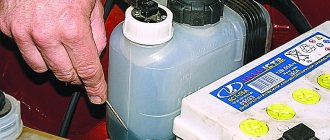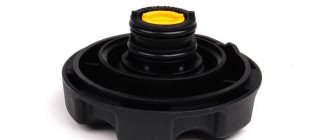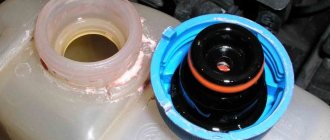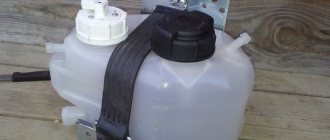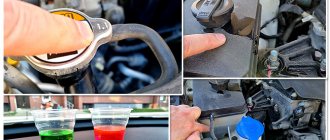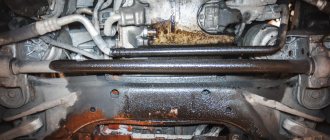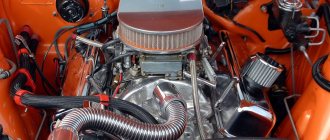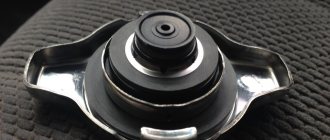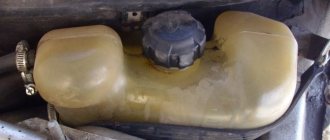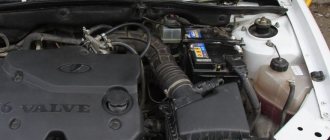The long evolution of the internal combustion engine could not change the main thing: it remained a heat engine, and therefore a lot depends on the serviceability of its cooling system. Touching upon the topic of the main causes of antifreeze leaks, we recalled the expansion tank cap as one of the likely options. Sometimes this small detail spoils the lives of many motorists and their cars much more than one can imagine. Today we will understand in detail what role it plays in the cooling system, and what can happen if it does not work properly, as well as how to buy a high-quality expansion tank cap and even repair it.
Why is an expansion tank cap needed?
The expansion tank acts as a compensation tank: when heated, the coolant noticeably expands in volume. In very old cars there was no separate expansion tank, and its role was played by the radiator itself.
The GAZ-21 cooling system did not have a separate expansion tank!
VAZ-2108: expansion tank with a cap, and the radiator without a cap
The radiator cap performed the same task as on modern cars: thanks to the presence of a steam outlet (exhaust) valve in the design, it maintained, albeit small, but excess pressure (0.45-0.55 kgf/cm2) in the system, which made it possible water boils only at 109-112 degrees.
Radiator plug device for GAZ-21
An air valve was also provided in the radiator cap, adjusted to a vacuum (0.01-0.10 kgf/cm2). His task was the opposite - to prevent the creation of too low pressure inside the system.
In the photo: radiator cap GAZ-21. The “Open with Care” sign warns that it must be handled with care.
The modern expansion tank cap, although it looks different from the “vintage” radiator cap, is designed similarly. As a rule, there are two valves inside the plastic case - outlet and inlet.
Device of the VAZ-2108 expansion tank plug: 1 — exhaust valve spring; 2 — inlet valve; 3- intake valve spring; 4 — outlet (steam valve); 5 — brass valve block; 6 - filler neck of the expansion tank.
The cover of the VAZ-2108 in disassembled form...
...and on the expansion tank
The task of the first is to “bleed off” the pressure if it has reached the limit provided by the manufacturer. Since modern engines have higher operating temperatures than engines of previous generations, the exhaust valves of the tank lid can open at a pressure of up to 1.5 kgf/cm2, and this parameter is strictly regulated for each specific engine.
The standard parameter for a VAZ plug is 1.1-1.2 atm
The inlet valve opens at 0.03-0.13 kgf/cm2, which avoids excessive vacuum in the system. Some manufacturers structurally combine two valves into one, but this does not change their essence.
Why is it necessary to control the pressure in the cooling system so precisely?
Maintaining the required system pressure is important for two reasons. First, it should not be too low so that the antifreeze can boil at a higher temperature than it does at atmospheric pressure. After all, many modern engines can heat up to 120 degrees or more during operation, while most coolants under normal conditions boil already at 110 degrees. Increased pressure avoids overheating and boiling of antifreeze even at high temperatures.
Well, secondly, the pressure in the cooling system should not be too high in order to avoid antifreeze leaks and ruptures of rubber pipes and the plastic expansion tank - that is, to keep the system sealed. By the way, the preservation of tightness is often hampered not only by poor-quality operation of the tank lid valves, but also by the seating surfaces of the filler neck or the threads on the lid itself: if they are poorly processed, expect leaks.
Nowadays, it is rare to see such quality of processing of the mating surfaces on Lada tanks sold in stores - and therefore you should not expect perfect tightness of the connections
The coolant level sensor (left) is another way to lose the tightness of the system with all the ensuing (in every sense) consequences
What types of lids are there?
Let's look at several different expansion tank caps using the front-wheel drive Lada as an example. You can find almost a dozen covers for it on sale from a variety of different manufacturers. They may differ noticeably in body color, inscriptions, threads and “filling,” but the essence does not change: the exhaust valve must operate at 1.1 atmospheres (as the pressure parameter kilogram-force per square centimeter is usually called in common parlance).
Both of these covers are brand new, but one is working and the other is not. But you can find out about this only after checking or installing it on the car
Unfortunately, the lids available on sale are good and bad, that is, high-quality and not so good. This means that they can allow excess pressure in the system to be noticeably higher than normal - 1.3-1.5 kgf/cm2 and even higher!
It will be too much... Such a cover can ruin many parts of the cooling system
Some caps can release pressure to the required level, but they take too long and are reluctant to do so. Well, the lid may not hold even half of the required excess pressure, opening the exhaust valve already at 0.5-0.6 atmospheres.
An exhaust valve that capitulates early is also bad
Both the one and the other, and the third are almost equally bad. In the first two cases, the excess pressure in the system will be maintained at a higher level; in the third, it will not reach the required parameter. That is, in the first two cases, the driver can find out about the malfunction of the cap only after a rupture of the pipe or expansion tank, and in the second, the car can “boil”, releasing steam through the tank cap, even if it is not hot outside.
Expansion tank cap for VAZ 2114 - a small part with important functions
As a rule, the cooling system creates normal conditions for engine operation. The system coolant is stored in the expansion tank. The operation of the engine and other components of the car often depends on the condition of such a part as the cap of the expansion tank of the VAZ 2114.
A bad cap can cause overheating and radiator failure, cooling fan and water pump failure, blown fan belts, thermostat malfunctions, coolant leaks, and serious engine damage due to overheating.
Conclusion
The article turned out to be quite long and I hope informative.
As you can see, one cap does a huge job and always monitors the pressure in your cooling system, so it needs to be changed approximately every six months. Or at least have a spare cover that is known to work if the installed one suddenly fails.
Design and principle of operation
Structurally, the lid is a locking element, which is equipped with two valves. The first valve serves to reduce pressure, the second - to supply atmospheric air and increase pressure in the tank. The principle of operation of the cover is associated with changes in the density of the coolant as it heats up and cools down.
When the engine starts running, the antifreeze heats up and its bulk density increases to 20-25%. Hot antifreeze warms up the air layer. The exhaust valve sensor is triggered, it opens, some of the air leaves the tank and the pressure returns to normal. The bleeding process is repeated periodically when the internal pressure of the system exceeds 1.1-1.5 atmospheres.
After turning off the engine, the antifreeze cools down and the pressure in the cooling system drops. When it drops below a critical level, the intake valve opens and atmospheric air is supplied to the system. The pressure in the system equalizes and the inlet valve closes.
Car roof rack - registration procedure and fines
- Lada Kalina;
- Ford Focus;
- Gazelle Next;
- Daewoo Lanos;
- Volkswagen Passat;
- Lada Priora;
- VAZ 2110;
- Renault Logan;
- Opel Astra;
- VAZ 2114;
- Chevrolet Lacetti, etc.
You already understand that the cap serves not only to prevent coolant from pouring out of the tank. This is also a pressure regulator in the system.
A valve is hidden inside the lid, usually made of plastic. It is he who takes on such responsibility. The valve is immersed inside the expansion tank and, as necessary, pumps or releases excess pressure.
Before buying a new element, if you suspect the old one is broken, you can check it. A similar type of locking mechanism should be selected.
Please note that all modern foreign cars, in the vast majority of cases, have switched to single-valve caps for expansion tanks. That is, only one valve design is physically present. It just can perform two functions at once. While on domestic cars you can still find a pair of valves. Each of them is responsible for performing a corresponding function. Whether this is good or bad is difficult to judge. But the fact remains a fact.
The lid is activated only when an excess or deficit of pressure is detected in the system. Each car has its own temperature and pressure standards for the element to operate.
Signs of trouble
The most critical signs of a faulty cap are steam coming from under the hood (if the engine temperature is not in the red sector, there is a 90% chance that the problem is in the cap) and/or swelling of the expansion tank.
You can also make an assumption that the cover is faulty if there is:
- coolant leaks from the tank;
- antifreeze leaks at joints;
- ruptures and swelling of hoses;
- air jams;
- engine overheating.
Steam, boiling liquid and leaks are associated with improper operation of the exhaust valve. Air locks are usually caused by a malfunctioning intake, or vacuum, valve. Bursts (swelling) of hoses can be caused by failures of both the exhaust and intake valves.
Air entrapment causes air pockets inside the heater core, thermostat, and radiator hoses. As a result, the engine will begin to overheat because the cooling system is unable to maintain a constant temperature.
If air pockets appear, you need to completely drain the old fluid and add new antifreeze. New liquid is poured in gradually, in small portions of 100 ml.
Verification Instructions
Trying to create pressure with your mouth in order to check the functionality of a potentially failed valve cover from the expansion tank is usually in vain. It is better to abandon such an idea. Otherwise, there is a risk of drinking antifreeze. And if he is also hot, then a visit to the hospital cannot be avoided.
The easiest way to check it is at a car service center. There are special pumps to create pressure. They pump the required number of atmospheres, which makes it clear whether the valve operates or not.
But many are interested in self-checking. It is also possible.
Here you need to act according to a certain algorithm.
- First, turn off the engine, let it cool for a while, then carefully unscrew the cap from the tank. Examine its condition visually. Any breaks in the seal, chips or cracks indicate the need for replacement;
- In the absence of mechanical damage, there is still no guarantee that the element is in working order. Screw the plug into place, turn on the engine at idle speed;
A fairly simple but effective way to check yourself. Its advantage is that this method is suitable for any car with a liquid engine cooling system.
There are alternative diagnostic options, but they cannot always be carried out due to the design features of the motor. If you can reach up and reach one of the thick hoses coming from the coolant reservoir. It is compressed, and before that the plug is unscrewed. Squeeze the hose, tighten the plug, and then release the tube. If it returns to its original shape, the valve performs its functions.
Despite such a modest size and external inconspicuousness, such an element of the cooling system has a huge impact on the performance of the entire engine. Therefore, you should definitely remember the reasons, signs and methods for diagnosing the condition of the valve plug on the expansion tank.
Thanks to everyone who reads us and leaves comments! Continue in the same spirit! We look forward to your feedback and pressing questions!
(
8 ratings, average: 3.88 out of 5)
Checking the cover
If there is reason that the cap may be faulty, how to check the cap of the expansion tank of a VAZ 2114?
In service centers, the test is performed on special stands with a pump and pressure gauge. The cover is screwed to the stand and the pump begins to supply air. When the pressure gauge reaches 1.5-1.7 atmospheres, the exhaust valve should operate. The operation of the intake valve is checked in the same way, only the air is pumped out from under the cover. If the valves do not operate, the expansion tank plug of the VAZ 2114 is faulty.
How can you test the cover in the field?
First you need to conduct a visual inspection. Chips, cracks, gaps and other surface damage are reasons to replace the part. Look at the pressure rating listed for the vehicle and compare it to the pressure rating printed on the part. If they do not match, replace the cover.
A few tips for maintaining a healthy system
You can avoid most problems, from minor troubles to serious damage associated with the expansion tank cap, if you follow a few rules. Professionals advise the following:
- Change the expansion tank cap at least once every 2-3 years. Aggressive coolant components attack mechanism parts and seals, gradually destroying them.
- Use only the original cover to replace a worn one. Some analogues do not allow the engine to operate at the required temperatures.
- Check and adjust the valves only on a cold engine, otherwise you risk getting burned from boiling water splashing out under pressure.
- Use tuned expansion tank caps only temporarily. Such a part will not provide optimal engine performance parameters and is therefore poorly suited for installation on a car.
In most cases, to restore the functionality of the mechanism, it is enough to simply clean the valves and rubber seals from dirt and sediment. If this procedure does not help, then it is easier to buy a new one, since modern expansion tank caps are made non-removable.
Finalization of the new cover
Unfortunately, the quality of spare parts for domestic cars leaves much to be desired, and it is better to check the new cover on a stand. If the pressure does not hold or excess pressure is not released, you can trim the springs. To do this, the part is disassembled, the sealing rubber is pryed off and removed with a screwdriver. Then use a screwdriver to carefully remove the inner cover and remove the springs.
The large spring is trimmed by one turn, and the small spring by two turns. As a result, the exhaust valve will begin to open at a pressure of 1 atmosphere, and not 1.7 atmospheres. When checking, the inlet valve should bleed freely.
How everything works
The main task of the sealing device on the expansion tank is to maintain a certain pressure for the system. In this case, the threaded connection must ensure a high contact density of the surfaces after screwing.
The expansion tank cap design assumes the presence of a built-in valve that ensures voltage balance. Depending on the current situation, one of the tasks is performed:
- the process of releasing excess volume into the atmosphere occurs;
- volume is pumped to get rid of the vacuum inside;
- the valve is in the closed position, without interaction with the surrounding space.
It must be taken into account that in old domestic cars two independent valves are responsible for pumping and releasing pressure. In modern machines, one valve is used for both operations.
What is the main role of the tank cap?
As is known, a running engine creates a pressure in the cooling system that differs from normal atmospheric pressure. This occurs due to the fact that the coolant heats up along with the engine, as a result of which it expands and increases in volume. As a result, the pressure inside the engine cooling system (ECS) increases, but it is not in contact with the external environment, and there is nowhere for it to relieve excess pressure.
Developers of modern cars do not fight the increased pressure in the ODS “radically” - they do not try to completely get rid of it. It is adjusted using the tank cap. Increased pressure in the SOD is used to shift the coolant boiling point. After all, it’s no secret that at normal atmospheric pressure for water it occurs at a temperature of 100 °C, for antifreeze – 105–110 °C, and for antifreeze – 120 °C. The operating temperature of modern car engines is very close to these critical values.
So, for example, for carburetor VAZs it should be in the range of 90–95 °C, and for injection ones – 97–105 °C.
However, under certain engine operating conditions, a short-term increase in its temperature occurs to higher values, which, however, does not lead to failure of a serviceable engine, but causes the same heating of the coolant. For example, on injection VAZ 2109 the liquid at such moments can be 120–125 °C. Obviously, even antifreeze cannot withstand such heat. At the same time, an increase in the pressure of any liquid leads to an increase in its boiling point.
Injection VAZ 2109
Engineers designing engines have long found out that to prevent the coolant from boiling even during short-term critical heating of the engine, it is enough to maintain the pressure in the coolant at the level of 1.1–1.5 kgf/cm 2 (1.1–1.5 bar). A higher temperature is not needed, because the engine is not designed for it, and it will lead to its failure. And it makes no sense to allow a greater spontaneous increase in pressure, which can nevertheless occur, because it will complicate the process of manufacturing and servicing the motor, as well as increase its cost, since it will require a more durable and sealed SOD (more durable pipes and expansion tank, strong clamps).
Therefore, the tank lid must be sealed, but only up to the required pressure limits indicated above, after reaching which it maintains them, connecting the system with the external environment as necessary to release the air compressed inside the expansion tank.
Cover device
It is important to understand that there is a locking element for expansion tanks on any car that has an internal combustion engine under the hood. And it doesn’t matter whether it’s diesel, gasoline or gas-powered.
Therefore, the problem with the failure of this unit can occur on any car, including such models as:
The design and principle of operation of the expansion tank cap
In order for the necessary pressure to be created in the SOD when the engine is running, the lid device ensures a tight, hermetically sealed closure of the tank. A safety valve is provided to relieve excess pressure. It operates (opens) only when the pressure inside the SOD becomes 1.1–1.5 kgf/cm2 (depending on the design of the lid and its manufacturer).
While it is lower, the valve is closed, and immediately after releasing the excess pressure to a value that is less than that indicated above - partial release of the air compressed in the tank - it closes. There is one more valve in the lid - the inlet valve, it is also called a vacuum valve. Its purpose is exactly the opposite of protective. The inlet valve serves to intake (suction) air into the SOD. The fact is that after stopping the engine, as you know, it begins to cool down. The coolant temperature also drops.
Inlet valve cover
At the same time, it decreases in volume, which is accompanied by a decrease in pressure inside the SOD. The coolant that enters the tank, upon its own heating, begins to flow back into the system, freeing up space for the air remaining in the expansion tank and ceasing to put pressure on it. Then there comes a moment when the pressure in the SOD is compared with the external atmospheric pressure. If at the same time the temperature of the coolant turns out to be higher than in the external environment, then it, continuing to cool, will further decrease in volume.
What types of lids are there?
It is practical to use covers designed for the OS of a specific car model. If you install a non-standard modification (if it fits the thread), it may not release excessive pressure in time or may not release excessive pressure at all.
Standard covers are a cheap option, but they often have one problem. Since the materials in them are cheap, the metal elements corrode faster, losing their elasticity. Also, sometimes the elements sinter, causing the valve to either freeze in the open position, or vice versa – in the closed position.
